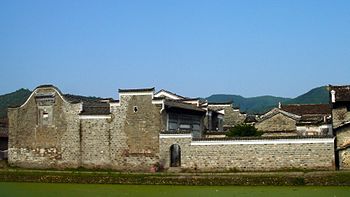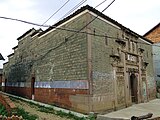Architecture of Jiangxi

Architecture of Jiangxi refers to the traditional masonry houses, residential compounds, monuments, and academies built in Jiangxi Province of East China.
Overview
Architectural features
History
15th to 16th century
This period refers to the early and middle Ming dynasty when China enjoyed an economic prosperity, and it can be witnessed by the grandiose features of architecture in Jiangxi. Despite the small number of the surviving buidings, their architectural features genuinely reflect the style of this period. Structural elements like Dougong were generally used, and the selection of raw materials was mainly those of big volumn. In decoration, animals like elephants, horses, qilin, phoenix are very representative at this time.
17th to 18th century
Jiangxi saw a large regress in economy as well as in other fields during this period due to the warfare and some natural disasters. While earlier style of grandeur could still be perceived, budgets of house building were relatively limited which led to a minimalist style in decoration. Geometric patterns and symbols of goodwill are the main theme of carvings.
19th century to present
Stimulated by a national trend of sophiscated aesthetics and also by improvements of handcraft, Jiangxi architecture evolved into an eleborately-decorated style. Carvings often took much more time than house buiding, while structural beauty was no longer the focus in architectural design. The use of dougong was largely reduced, and some decorative parts were even coloured with mineral pigments.
Materials
Natural materials are highly preferred. Raw materials, such as stone, wood, and brick, are abundantly used for the respect for nature. Stone, as the fundamental part in the construction, is variable across different regions; sandstone, limestone, granite are the most frequent choices. Wood is generally used for the framework of buidings, because of its warmth and workability. Compared to the style in surrouding regions like Zhejiang or Anhui where outer walls are painted white with quicklime, bricks are explicitly viewed in Jiangxi architecture, which therefore demands well-developed techniques to produce fine bricks.
Fengshui design
Fengshui theories have been playing an important role in the entire course of construction, for instance, choosing the site, house direction, etc..
Jiangxi school
Jiangxi school (Chinese: 江西派), also called Xingshi school (Chinese: 形势派, literally "school of location") is a prominent school in Chinese Fengshui, which emphasizes the harmony between nature and human, namely between environment and residents. Yang Junsong (Chinese:杨筠松) is the founder of this school.
Building types
Jiangxi residential architecture is renowned for its exterior and interior design, relating to the surrounding context and settings by using Fengshui principles.
The traditional houses still preserved in Jiangxi were mostly built during the Ming dynasty and Qing dynasty. These buildings are characterized by gables of dark bricks, with white lines under eaves, covered by black tiles. They are often elaborately decorated by wood, stone and brick carvings, ink painting, clay sculpture, and sometimes Nuoxi elements.
Important historical monuments built in Jiangxi in the traditional styles include ancestral shrines, Shuyuan (Confucian) academies, and paifang (memorial arches).
Residential architecture
Memorial architecture
Educational architecture
Recreational architecture
Religious architecture
Decorative structures
Stone carving
Stone carving in Jiangxi architecture is very much outstanding as Jiangxi has abundant resources of many kinds of stones. Roughly speaking, sandstone is preferred in western Jiangxi and limestone is usually seen in the east, while granite is typically used in northwestern region. However, the combination of different stones can also be viewed for seeking aesthetics. Stone is elaborately carved, especially at entrance door, column bases and other visible parts inside the building.
Wood carving
As a major aspect in interior decoration, wood carving often costs the most amount of time and money in the construction. In consequence, carpenters are greatly valued and respected. The content of wood carving are often inspired from historical stories or traditional cultures, such as Wufu, Shou, 24 Xiao, etc..
Brick carving
Brick carving is comparatively less often applied in Jiangxi architecture, however, classic work can still be found. A renowned example is a residence in Yihuang County, built in 1755, and its entire entrance is decorated with finely-carved bricks.
Ink painting
Infrastructure
Defensive wall
Pavement
Bridge
Water well
Significant buildings and areas
Major National Historical and Cultural Sites
- White Deer Grotto Academy, one of the Four Great Academies of China
- Traditional Architecture of Liukeng Village
- Paifang of Grave of Zhu Shi
- Yuanzhou Drum Tower
- Ehu Academy
- Bailuzhou Academy
- Paifang of Chen Family
- Qingyunpu, residence of Bada Shanren
- Guanyin Bridge
- Mingshui Bridge
- Fengqu Bridge
- Wannian Bridge
- Ganzhou City Walls
- Wan'an City Walls
- Ancestral shrine of Jia family
- Longxuetushi Paifang and Cishichuanfang Paifang
- Confucian Temple of Anfu
- Wanshou Palace of Fuzhou
- Yuceshanguan and Yutingbieshu villas
- Shiwuli residence of Yiqian
Influence on neighbourhood
Regional difference
Gallery
Ancestral halls and shrines
-
Ancestral shrine in Ji'an
-
Huangcun Jingyitang, Wuyuan County, Jiangxi.
-
Door of Huangcun Jingyitang.
-
Bed chamber of Huangcun Jingyitang.
-
Yu Family Ancestral Hall, Wangkou Village.
-
More Yu Family Ancestral Hall.
Pavilion
-
Pavilion of Prince Teng at Nanchang, Front view.
-
Pagoda of Prince Teng.
-
A picture of Pavilion of Prince Teng.
City Wall
-
Ganzhou's City Wall.
Others
-
Imperial Kiln in Jingdezhen.














